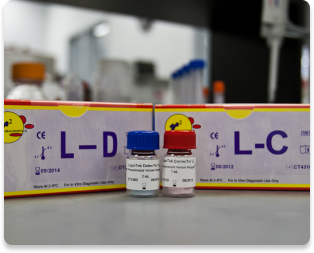LupoTek Detectin VL and LupoTek Correctin VL

Please Contact Us
Or call us at 888-727-2729 for current pricing.
Assay Type
Description
Intended Use
Uses
Ordering Information
| Catalog # | Product | Kit Configuration | Regulatory Classification | Product Insert (PDF) |
|---|---|---|---|---|
| 85-202 | LupoTek Detectin VL | 10 x 2 mL | 510(k), CE | LupoTek Cor and Det VL_IFU |
| 86-201 | LupoTek Correctin VL | 10 x 1 mL | 510(k), CE | LupoTek Cor and Det VL_IFU |
Principle of the Test
The hallmark characteristic of lupus anticoagulants is their phospholipid dependence; that is, the prolonged clotting time seen with low phospholipid reagents is corrected with high phospholipid reagents. The Dilute Russell Viper Venom time (DRVVT) is a simple one stage clotting test which can be used with carefully matched low and high phospholipid reagents to detect Lupus Anticoagulants with minimal interference from other types of circulating anticoagulants.
LupoTek DetecTin VL and LupoTek CorrecTin VL use Vipera lebetina venom rather than Vipera russelli (Russell’s Viper) venom. Vipera lebetina venom, like Russell’s viper venom, will directly activate Factor X without requiring Factor VII. The activated Factor X in conjunction with Factors V, II, calcium ions and phospholipid will generate thrombin which converts fibrinogen to fibrin, producing a clot in the test system. LupoTek DetecTin VL, the low phospholipid reagent, is designed as the screening reagent to detect a prolongation of the clotting time. LupoTek CorrecTin VL is the high phospholipid reagent that neutralizes the LA and corrects the clotting time to normal, confirming the presence of a Lupus Anticoagulant
Reporting Units
The clotting times obtained with the DetecTin VL and CorrecTin VL reagents are used to express results as a normalized ratio. The use of a normalized ratio, in which the patient’s clotting times are divided by the clotting time of pooled normal plasma with the respective reagent, minimizes any impact of differences in the normal ranges due to lot-to-lot reagent variability.
Handbooks and Guidelines
- Van Cott E and Eby C, Chapter 22, “Antiphospholipid Antibodies”, in An Algorithmic Approach to Hemostasis Testing, KottkeMarchant ed., CAP Press, 2008
- Greaves M, Chapter 16 “Evaluation of Antiphospholipid Antibodies”, in Quality in Laboratory Hemostasis and Thrombosis, Kitchen, Olson, and Preston ed., Wiley-Blackwell, 2009.
- Brandt JT et al, “Criteria for the diagnosis of lupus anticoagulants, an update: on behalf of the Subcommittee on Lupus Anticoagulants/Antiphospholipid Antibodies of the ISTH”, Thrombosis and Hemostasis 74:1597, 1995.
- Pengo V et al, “Update of the guidelines for lupus anticoagulant detection”, Journal of Thrombosis and Hemostasis 7:1737, 2009.
- Clinical Laboratory Standards Institute, “Laboratory Testing for the Lupus Anticoagulant; Proposed Guideline“, under development.
